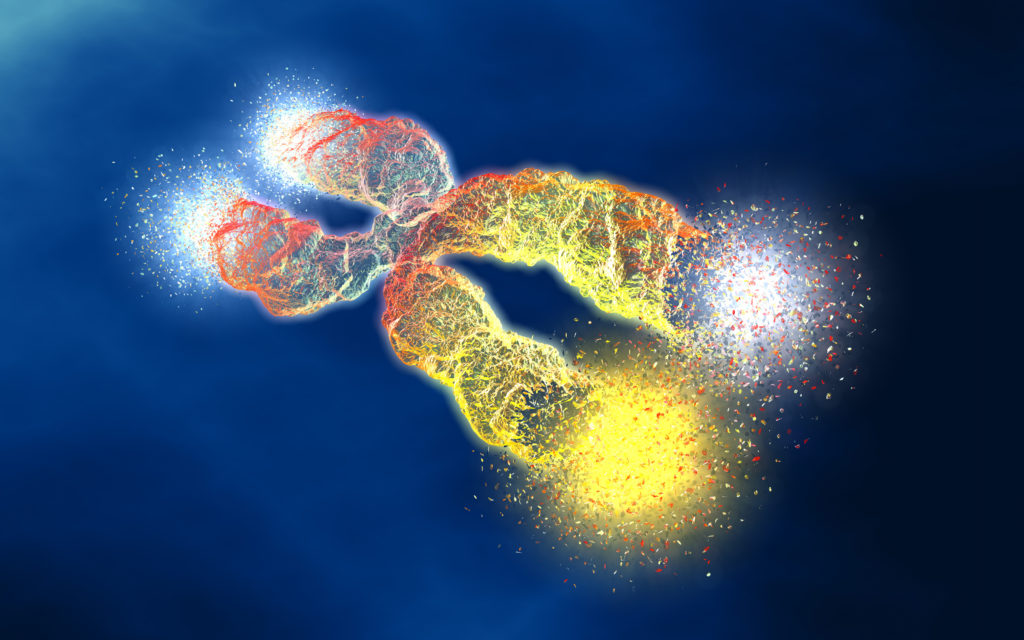
Telomeres are the protective end-caps that seal the DNA’s genetic information. Located at both ends of chromosomes, telomeres protect the genome from degradation and unnecessary chromosome recombination, repair, and fusion. Each time a cell replicates, its telomeres are slightly shortened. The length of the telomere reflects the age of the cell and the time it has left until it reaches senescence.
“Telomere length maintenance is required for long-term ‘healthy’ division of cells.”
The enzyme telomerase modulates telomere length. The amount of telomerase in the body can change with age, diet, weight, stress, disease, and other factors. Less of this enzyme leads to shorter telomeres, reduces the ability of cells to replicate, and can lead to senescence, apoptosis, and even oncogenesis. Researchers recently began to consider targeting telomeres and telomerase within cancer cells to disrupt the chromosome, induce chromosome instability (CIN), reduce proliferation, and help drive cancer cells toward apoptosis.
“Telomerase/telomere-targeting therapy is a potentially promising approach for cancer treatment because even transient telomere dysfunction can induce chromosomal instability (CIN) and may be a barrier to tumor growth.”
Researchers from the National Institutes of Health, University Paris-Saclay, Kazusa DNA Research Institute, and the University of Edinburgh used a dual-Human Artificial Chromosome (HAC) assay to analyze the genomic activity of six telomere-targeting platinum compounds. Their study was chosen as the cover paper of Oncotarget’s Volume 12, Issue 15, entitled, “Terpyridine platinum compounds induce telomere dysfunction and chromosome instability in cancer cells.”
The Study
The dual-HAC assay was previously created by the researchers in this study to detect compounds that induce CIN through telomere dysfunction. This assay consists of two cell lines: one with telomeres, and one without. Disruption of the cell lines with telomeres denotes compound-induced CIN, and indicates potentially efficacious cancer therapeutics in vivo.
“Recently we developed a dual-HAC-based assay allowing quantitative comparison of the efficiency and specificity of compounds to induce telomere dysfunction [36].”
Pt-tpy, a terpyridine platinum compound, and five of its structurally modified derivatives were assayed to determine their efficacy in creating genomic instability in cancer cells via telomere disruption. The team evaluated the six compounds using two isogenic human fibrosarcoma cell lines, the dual-HAC assay, FISH analysis of EGFP-HACs, telomere fluorescent in situ hybridization (Telo-FISH), flow cytometry, calculation of the rate of spontaneous HAC loss and after compound treatment, cell viability testing for measuring HAC loss in response to drug treatment, cytokinesis-block micronucleus assay, immunofluorescence, and statistical analysis.
“We found that treatment of cancer cells with either Pt-cpym, Pt-vpym, Pt-ttpy or Pt-tpy induces telomere dysfunction leading to high levels of chromosome instability.”
Conclusion
The researchers thoroughly explored the genomic activity of this set of compounds using the biologically relevant dual-HAC assay and compared them to Pt-ttpy—a derivative previously evaluated in another study. They found that three terpyridine platinum compounds, Pt-tpy, Pt-vpym and Pt-cpym, induce the highest levels of CIN.
“Thus, these terpyridine platinum compounds potentially serve as onco-therapeutic agents for cancers.”
Click here to read the full scientific study, published by Oncotarget.
YOU MAY ALSO LIKE: More Oncotarget Videos on LabTube
—
Oncotarget is a unique platform designed to house scientific studies in a journal format that is available for anyone to read—without a paywall making access more difficult. This means information that has the potential to benefit our societies from the inside out can be shared with friends, neighbors, colleagues, and other researchers, far and wide.
For media inquiries, please contact media@impactjournals.com.



